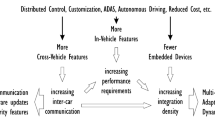Abstract
Cars have evolved a lot since their introduction and will evolve even more. Today’s cars would not work without the software that is embedded in their electronics. Although the physical processes are often the same as in the cars’ of the 1990s (combustion engines, servo steering), they become computer platforms and are able to “think” and drive autonomously. In this chapter we look into a few trends which shape automotive software engineering—autonomous driving, self-* systems, big data and new software engineering paradigms. We look into how these trends can shape the future of automotive software engineering.
Access this chapter
Tax calculation will be finalised at checkout
Purchases are for personal use only
Preview
Unable to display preview. Download preview PDF.
Similar content being viewed by others
References
National Highway Traffic Safety Administration et al. Preliminary statement of policy concerning automated vehicles. Washington, DC, pages 1–14, 2013.
Eric Armengaud, Matthias Biehl, Quentin Bourrouilh, Michael Breunig, Stefan Farfeleder, Christian Hein, Markus Oertel, Alfred Wallner, and Markus Zoier. Integrated tool chain for improving traceability during the development of automotive systems. In Proceedings of the 2012 Embedded Real Time Software and Systems Conference, 2012.
Matthias Biehl, Chen DeJiu, and Martin Törngren. Integrating safety analysis into the model-based development toolchain of automotive embedded systems. In ACM Sigplan Notices, volume 45, pages 125–132. ACM, 2010.
Jan Bosch. Speed, data, and ecosystems: The future of software engineering. IEEE Software, 33(1):82–88, 2016.
Sagar Behere and Martin Törngren. A functional reference architecture for autonomous driving. Information and Software Technology, 73:136–150, 2016.
Betsy Burton and David A Willis. Gartner’s Hype Cycles for 2015: Five Megatrends Shift the Computing Landscape. Recuperado de: https://www.gartner.com/doc/3111522/gartners--hype--cycles--megatrends--shift, 2015.
Larry Downes and Paul Nunes. Big Bang Disruption: Strategy in the Age of Devastating Innovation. Penguin, 2014.
Ulf Eliasson, Rogardt Heldal, Jonn Lantz, and Christian Berger. Agile model-driven engineering in mechatronic systems-an industrial case study. In Model-Driven Engineering Languages and Systems, pages 433–449. Springer, 2014.
Lee Gomes. When will Google’s self-driving car really be ready? It depends on where you live and what you mean by “ready” [News]. IEEE Spectrum, 53(5):13–14, 2016.
Angelos D Keromytis. Characterizing self-healing software systems. In Proceedings of the 4th international conference on mathematical methods, models and architectures for computer networks security (MMM-ACNS), 2007.
Aaron M Kessler. Elon Musk Says Self-Driving Tesla Cars Will Be in the US by Summer. The New York Times, page B1, 2015.
Hiroyuki Kurihata, Tomokazu Takahashi, Ichiro Ide, Yoshito Mekada, Hiroshi Murase, Yukimasa Tamatsu, and Takayuki Miyahara. Rainy weather recognition from in-vehicle camera images for driver assistance. In IEEE Proceedings. Intelligent Vehicles Symposium, 2005., pages 205–210. IEEE, 2005.
James Manyika, Michael Chui, Brad Brown, Jacques Bughin, Richard Dobbs, Charles Roxburgh, and Angela H Byers. Big data: The next frontier for innovation, competition, and productivity. 2011.
Mahshad M Mahally, Miroslaw Staron, and Jan Bosch. Barriers and enablers for shortening software development lead-time in mechatronics organizations: A case study. In Proceedings of the 2015 10th Joint Meeting on Foundations of Software Engineering, pages 1006–1009. ACM, 2015.
Peter Manhart and Kurt Schneider. Breaking the ice for agile development of embedded software: An industry experience report. In Proceedings of the 26th international Conference on Software Engineering, pages 378–386. IEEE Computer Society, 2004.
Viktor Mayer-Schönberger and Kenneth Cukier. Big data: A revolution that will transform how we live, work, and think. Houghton Mifflin Harcourt, 2013.
A Pasztor. Tesla unveils all-wheel-drive, autopilot for electric cars. The Wall Street Journal, 2014.
Dewayne E Perry and Alexander L Wolf. Foundations for the study of software architecture. ACM SIGSOFT Software Engineering Notes, 17(4):40–52, 1992.
Eric Richardson. What an agile architect can learn from a hurricane meteorologist. IEEE software, 28(6):9–12, 2011.
Eric Ries. The lean startup: How today’s entrepreneurs use continuous innovation to create radically successful businesses. Random House LLC, 2011.
Helen Sharp, Nathan Baddoo, Sarah Beecham, Tracy Hall, and Hugh Robinson. Models of motivation in software engineering. Information and Software Technology, 51(1):219–233, 2009.
Purnendu Sinha. Architectural design and reliability analysis of a fail-operational brake-by-wire system from iso 26262 perspectives. Reliability Engineering & System Safety, 96(10):1349–1359, 2011.
Florian Sagstetter, Martin Lukasiewycz, Sebastian Steinhorst, Marko Wolf, Alexandre Bouard, William R Harris, Somesh Jha, Thomas Peyrin, Axel Poschmann, and Samarjit Chakraborty. Security challenges in automotive hardware/software architecture design. In Proceedings of the Conference on Design, Automation and Test in Europe, pages 458–463. EDA Consortium, 2013.
Miroslaw Staron and Wilhelm Meding. Monitoring Bottlenecks in Agile and Lean Software Development Projects–A Method and Its Industrial Use. Product-Focused Software Process Improvement, pages 3–16, 2011.
Miroslaw Staron, Rakesh Rana, and Jörgen Hansson. Influence of software complexity on iso/iec 26262 software verification requirements. 2015.
Miroslaw Staron and Riccardo Scandariato. Data veracity in intelligent transportation systems: the slippery road warning scenario. In Intelligent Vehicles Symposium, 2016.
Alex Wright. Hacking cars. Communications of the ACM, 54(11):18–19, 2011.
Author information
Authors and Affiliations
Rights and permissions
Copyright information
© 2017 Springer International Publishing AG
About this chapter
Cite this chapter
Staron, M. (2017). Current Trends in Automotive Software Architectures. In: Automotive Software Architectures. Springer, Cham. https://doi.org/10.1007/978-3-319-58610-6_9
Download citation
DOI: https://doi.org/10.1007/978-3-319-58610-6_9
Published:
Publisher Name: Springer, Cham
Print ISBN: 978-3-319-58609-0
Online ISBN: 978-3-319-58610-6
eBook Packages: Computer ScienceComputer Science (R0)




